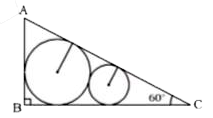In a right angled triangle ∠Band∠A are acute angles. If ∠A−∠B=k, where A and B are integers, then how many integer values can 'k' take?
A)80
B)88
C)45
D)89
The correct Answer is:D
To solve the problem, we need to analyze the properties of angles in a right-angled triangle.
1. Understanding the Triangle: In a right-angled triangle, one angle is 90 degrees. Let's denote the angles as follows:
- Angle A
- Angle B
- Angle C = 90 degrees (the right angle)
2. Sum of Angles: The sum of angles in any triangle is 180 degrees. Therefore, for our triangle:
Angle A+Angle B+Angle C=180∘
Since Angle C is 90 degrees, we have:
Angle A+Angle B=90∘
3. Defining k: According to the problem, we have:
Angle A−Angle B=k
4. Expressing Angle A: From the equation Angle A+Angle B=90∘, we can express Angle A in terms of Angle B:
Angle A=90∘−Angle B
5. Substituting in k: Now, substituting this expression into the equation for k:
k=(90∘−Angle B)−Angle B
Simplifying this gives:
k=90∘−2×Angle B
6. Finding the Range of k: Since Angle B is an acute angle, it must be between 0 and 90 degrees:
- If Angle B=0∘, then k=90∘−2×0∘=90∘.
- If Angle B=90∘, then k=90∘−2×90∘=−90∘.
- Therefore, the range of k is:
−90<k<90
7. Finding Integer Values: The integer values of k can range from -89 to 89. This gives us:
k=−89,−88,−87,…,0,…,87,88,89
8. Counting Integer Values: To find the total number of integer values:
- From -89 to 89, we have:
89−(−89)+1=89+89+1=179
However, since we need to consider only the values where k is formed by the difference of two acute angles, we need to exclude the extremes (0 and 90 degrees).
Therefore, the valid integer values for k are from -89 to 89, which gives us:
89−(−89)=178(excluding 0)
Thus, the total integer values k can take is 89.
Final Answer:
The number of integer values that k can take is 89.
- Angle A
- Angle B
- Angle C = 90 degrees (the right angle)
Angle A+Angle B+Angle C=180∘
Since Angle C is 90 degrees, we have:
Angle A+Angle B=90∘
Angle A−Angle B=k
Angle A=90∘−Angle B
k=(90∘−Angle B)−Angle B
Simplifying this gives:
k=90∘−2×Angle B
- If Angle B=0∘, then k=90∘−2×0∘=90∘.
- If Angle B=90∘, then k=90∘−2×90∘=−90∘.
- Therefore, the range of k is:
−90<k<90
k=−89,−88,−87,…,0,…,87,88,89
- From -89 to 89, we have:
89−(−89)+1=89+89+1=179
However, since we need to consider only the values where k is formed by the difference of two acute angles, we need to exclude the extremes (0 and 90 degrees).
89−(−89)=178(excluding 0)
Thus, the total integer values k can take is 89.
The number of integer values that k can take is 89.
Topper's Solved these Questions
Similar Questions
Knowledge Check
In a right angled triangle ∠Band∠A are acute angles. If ∠A−∠B=k, where A and B are integers, then how many integer values can 'k' take?
A80B88C45D89In figure, ∠B<∠Aand∠C<∠D then
 AAD<BCBOD>OCCOB<OADNone of these
AAD<BCBOD>OCCOB<OADNone of theseIn a triangle ABC, if ∠A>∠B>∠C and the measures of ∠A,∠B and ∠C in degrees are integers, then the least possible value of ∠A is
A70∘B65∘C60∘D61∘
Given that ∠A and ∠B are complementary angles. If ∠A=∠B+20∘, then find ∠A and ∠B
View SolutionABC is a right angled triangle in which ∠B=90∘andAB=BC. Find ∠Aand∠C.
View Solution∠A and ∠B are complementary angles. If ∠A=x+20∘ and ∠B=x−10∘, find ∠A and ∠B.
View SolutionIn a ΔABC,∠C=3∠B=2(∠A+∠B) find the three angles.
View SolutionIn a right angle triangle ABC. ∠B is a right angle and ∠C=60∘. If radius of small circle is 1 cm. then find R = ?

View Solution
